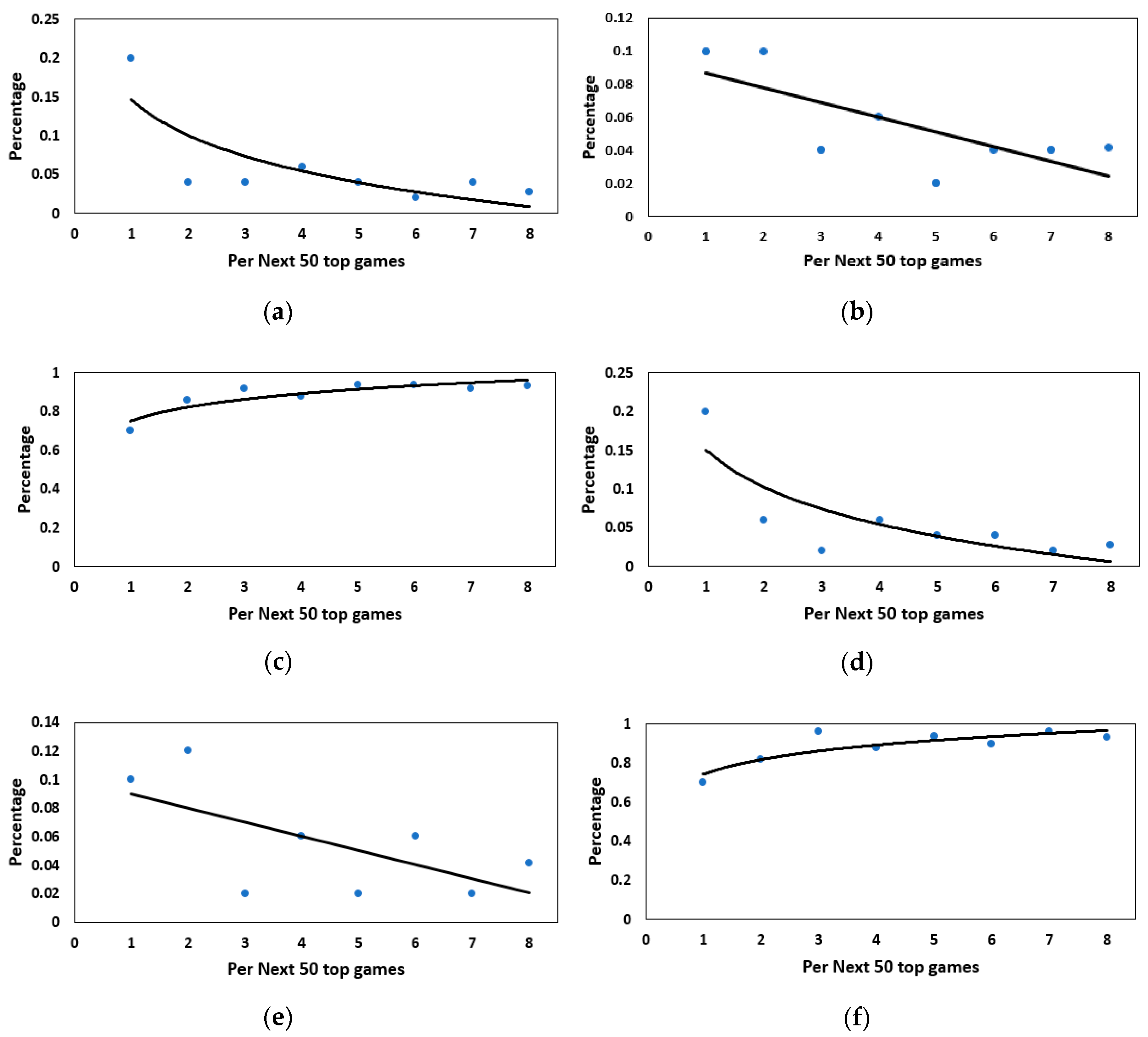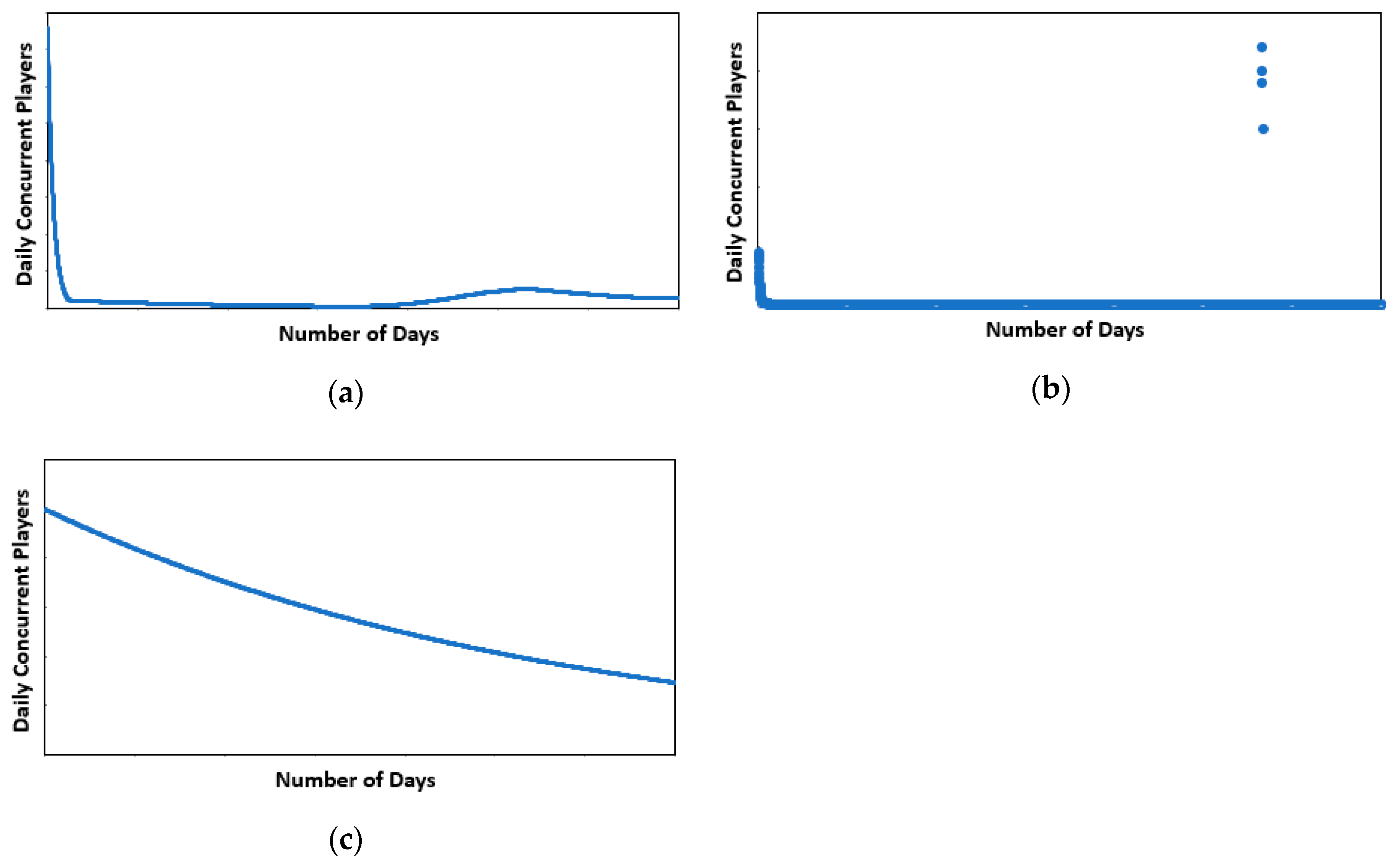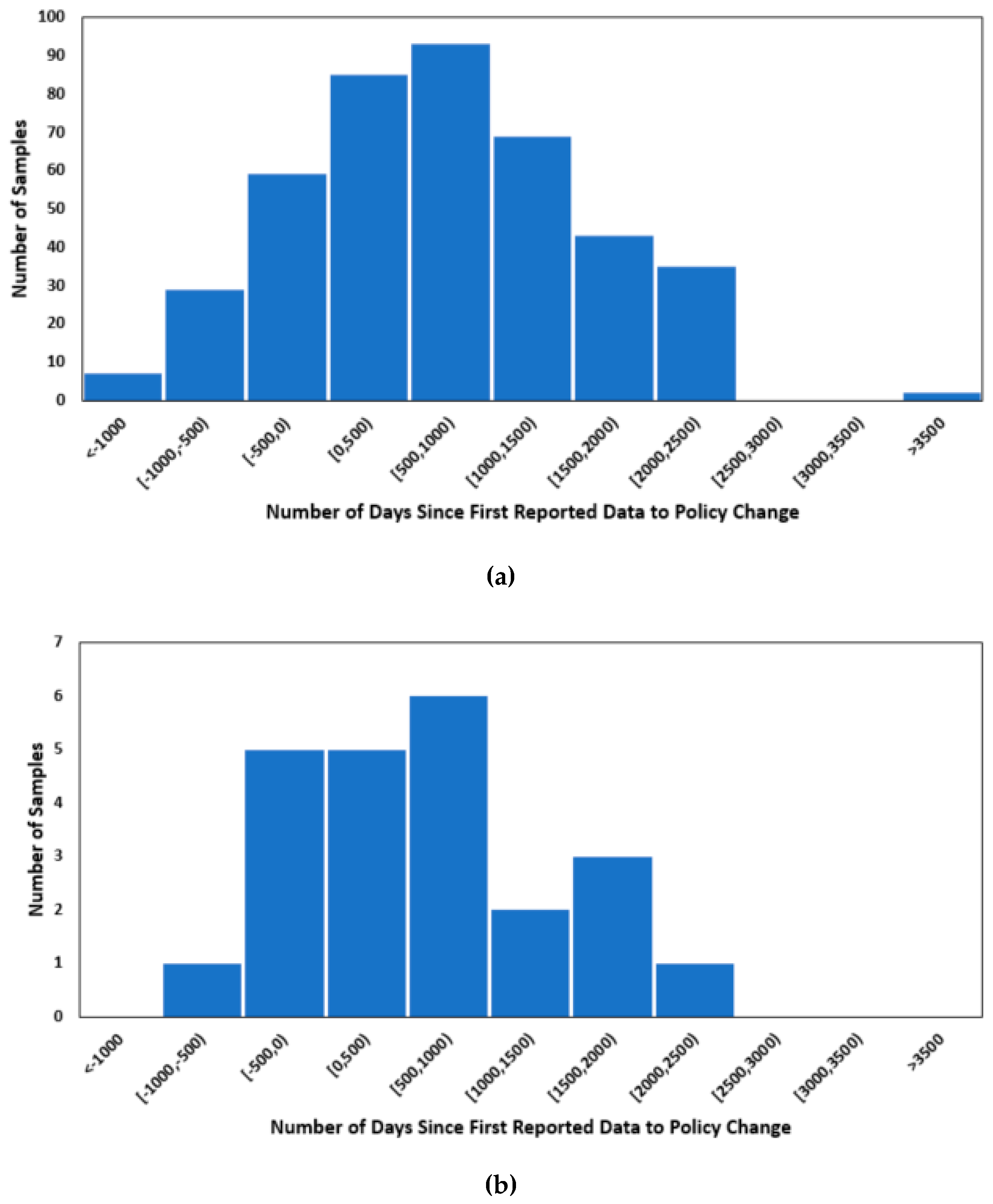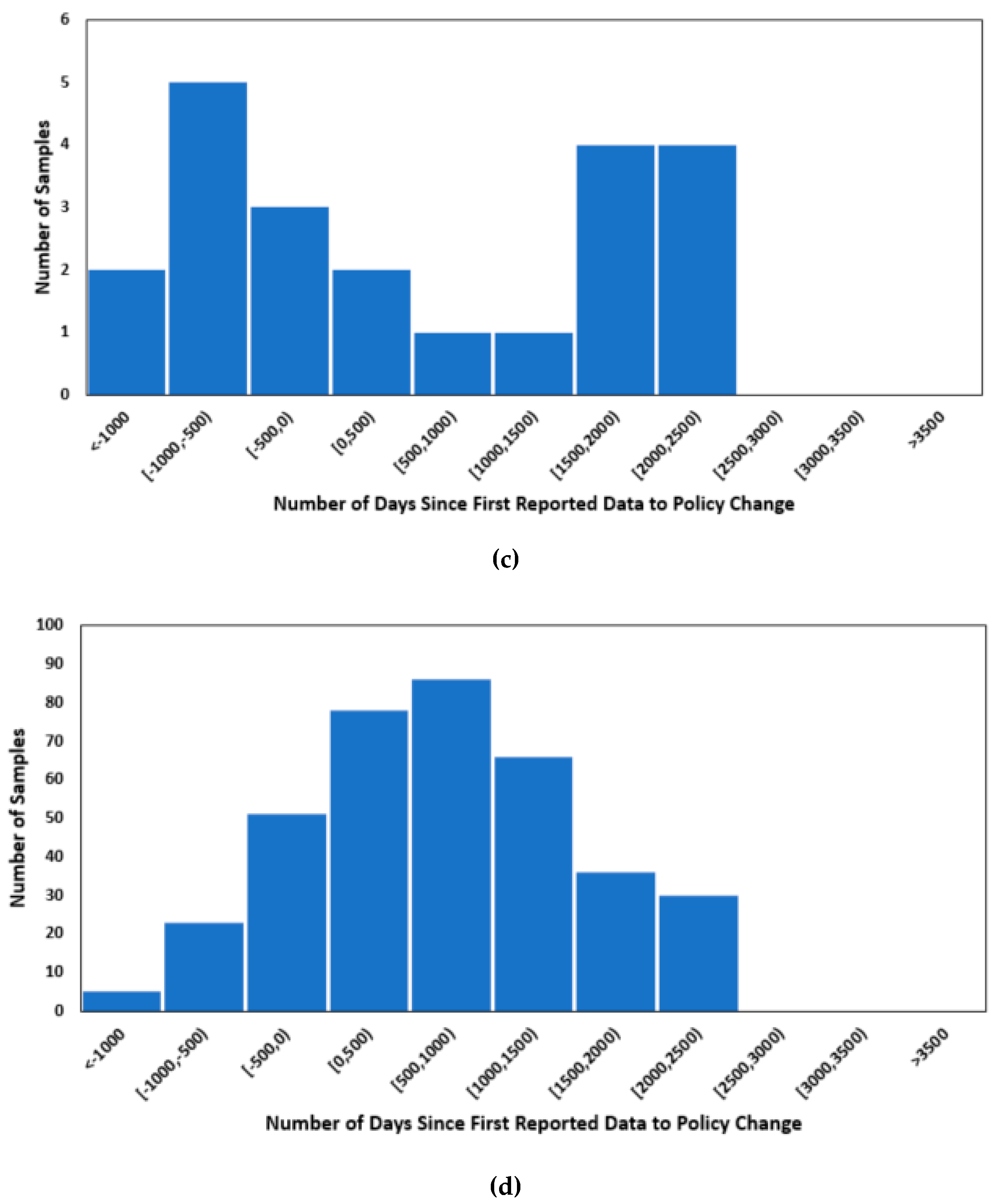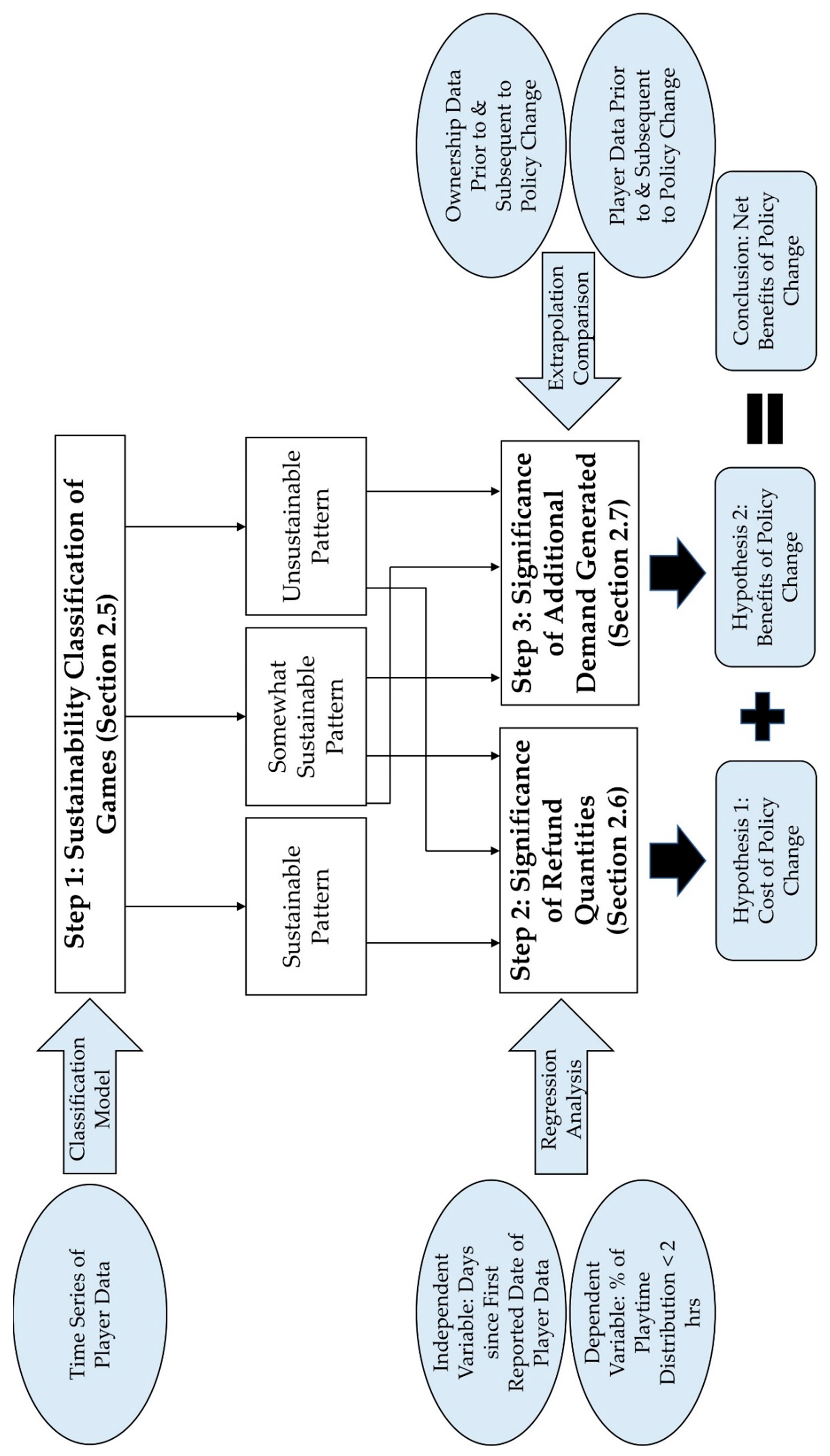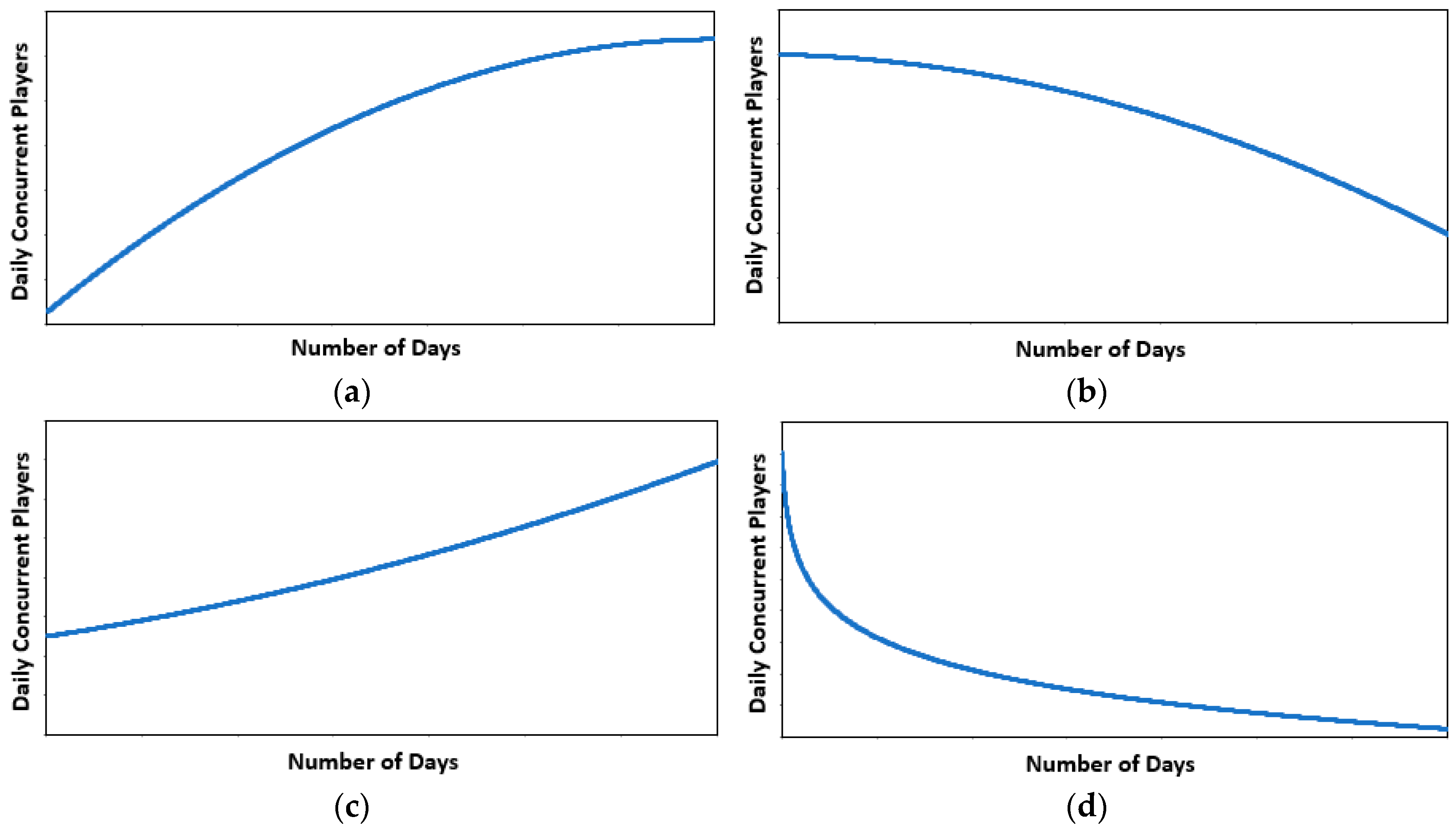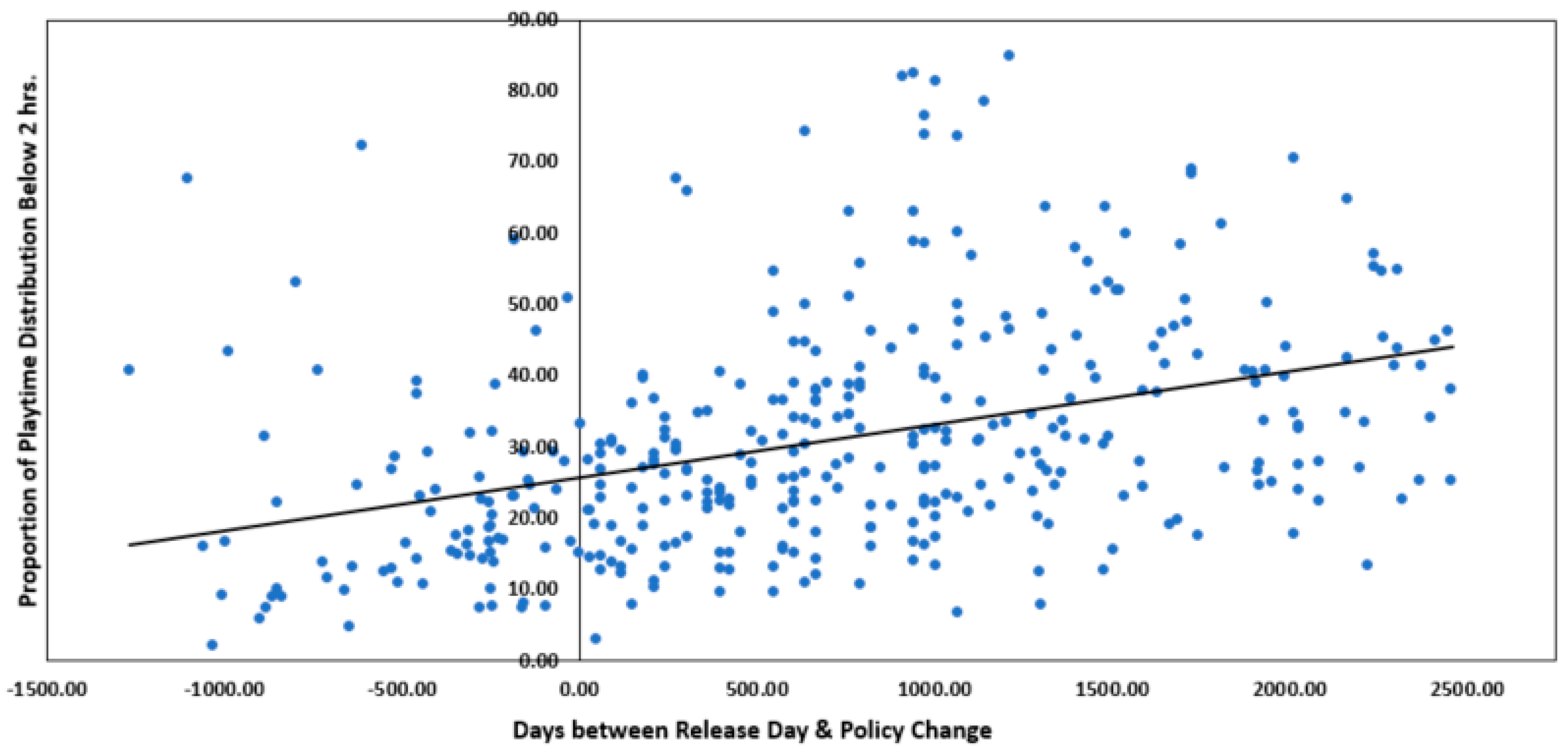Appendix A. Sufficiency of Sample Size
As previously alluded to, concerns may be raised around the small sample size among sustainable and somewhat sustainable games. The following section rationalizes the small sample size, highlighting the negligible value added from expanding the sample size. First, considering that approximately half of Steam’s revenue is generated by the top 100 games [
25], an analysis that incorporates the historically top 678 games encompasses most of the revenue produced. Hence, as these games are primarily responsible for Steam’s profitability and platform leadership, they also serve as the primary field of interest. Furthermore, games that possess a low playtime median manifest high volatility, as depicted in Model III of
Table 3, potentially invoking noise toward the identification of significant relationships. Thus, as the sample is extended toward increasingly less popular games, the volatility and consequently the standard error is likely to increase, potentially concealing correlations that could have originally been observed.
Finally, high attention is specifically paid to the strategic management of sustainable games.
Figure A1 and
Figure A2 utilizes the sample employed in the analysis of refund quantities (
Section 2.6) and additional revenues (
Section 2.7) respectively, and illustrates the percentage of games existing in each classification pattern as each segment of the top 50 games is taken, ordered according to the quantity of owners. A trendline of best fit is placed on each constructed graph. To ensure that the presence of free weekends does not inappropriately inflate ownership data in certain games, the analysis is conducted on both 11 November and 25 November 2018. Results are similar among both tests, conveying a quickly declining logarithmic curve for the sustainable game pattern and a negatively sloped linear trendline for somewhat sustainable games. Both regressions highlight the swift decline in the number of sustainable and somewhat sustainable games discovered as increasingly less popular games are selected. Hence, the extension of the sample will likely yield minimal additional quantities of sustainable and somewhat sustainable games, providing limited expansion to the sample size and little value to the conclusions achieved.
Figure A1.
Best-fit trendline displaying relationship between percentage of each sustainability pattern per progression of 50-game popularity segment, using sample size from
Section 2.6. Significance of Reductions in Existing Revenue: (
a) Sustainable pattern—November 11 (
b) Somewhat sustainable pattern—November 11 (
c) Unsustainable pattern—November 11 (
d) Sustainable pattern—November 25 (
e) Somewhat sustainable pattern—November 25 (
f) Unsustainable pattern—November 25.
Figure A1.
Best-fit trendline displaying relationship between percentage of each sustainability pattern per progression of 50-game popularity segment, using sample size from
Section 2.6. Significance of Reductions in Existing Revenue: (
a) Sustainable pattern—November 11 (
b) Somewhat sustainable pattern—November 11 (
c) Unsustainable pattern—November 11 (
d) Sustainable pattern—November 25 (
e) Somewhat sustainable pattern—November 25 (
f) Unsustainable pattern—November 25.
Figure A2.
Best-fit trendline displaying relationship between percentage of each sustainability pattern per progression of 50-game popularity segment, using sample size from
Section 2.7. Significance of Additional Revenue Flow: (
a) Sustainable pattern—November 11 (
b) Somewhat sustainable pattern—November 11 (
c) Unsustainable pattern—November 11 (
d) Sustainable pattern—November 25 (
e) Somewhat sustainable pattern—November 25 (
f) Unsustainable pattern—November 25.
Figure A2.
Best-fit trendline displaying relationship between percentage of each sustainability pattern per progression of 50-game popularity segment, using sample size from
Section 2.7. Significance of Additional Revenue Flow: (
a) Sustainable pattern—November 11 (
b) Somewhat sustainable pattern—November 11 (
c) Unsustainable pattern—November 11 (
d) Sustainable pattern—November 25 (
e) Somewhat sustainable pattern—November 25 (
f) Unsustainable pattern—November 25.
Appendix C. Age Distribution of Sample Size
As the devised classification model utilizes a relative measure of game quality, concerns may be raised around the robustness of classifications. More specifically, high-aged games are at increased likelihood to reach a stage of decline or obsolescence, potentially resulting in an ongoing contemporary player base at diminished levels. The proposed model employs a comparison between the average of the former and latter half of data, with an inferior sustainability pattern placed when the first half exceeds the second. As such, mature games may be more likely to be classified toward a lower sustainability pattern, due to continuously receding values in the latter half of data. If this bias is significant, the model’s approach in employing a relative measure to segregate games could be detrimentally flawed.
To ensure that this potential limitation has minimal impact and can be disregarded, a histogram analysis is conducted over the sample each classification group and compared to the distribution of the entire sample. If the bias is significant, a right-skewed and left-skewed distribution will be observed for the sustainable and unsustainable classification respectively. Conversely, if all patterns display a similarly shaped distribution, the limitation can be assumed to be negligible.
Figure A4a illustrates a comprehensive histogram containing all samples analyzed. The
x-axis portrays the intervals of game ages, or more specifically, the number of days between the policy modification and the first day of reported data. The
y-axis depicts the quantity of samples that are encompassed by each range. As illustrated, the construct is normally distributed around the interval bracket of 500 to 1000 days. Two games carry launch dates above 3500 days before the policy change, suggesting outlier characteristics. This is consistent with
Section 3.1. High-Level Analysis of Reductions in Existing Revenue, where both data points were previously eliminated.
Figure A4b portrays the distribution of sample age for sustainable games. The histogram substantially imitates the prior comprehensive distribution (
Figure A4a), including a peak around the 500- to 1000-day interval as well as minimal quantities around the first 2 brackets. Minor discrepancies can be observed, though this can be attributed to the low sample size.
Figure A4c illustrates the distribution for the sample of the somewhat sustainable pattern. The histogram paints a somewhat contrary shape, with high quantity of games in both recent and mature games, resulting in the necessity for further examination. Recall from designed classification procedures (
Section 2.5) that a polynomial trendline is placed on the time-series data of concurrent daily users. Four classification scenarios encompassing the 3 sustainability patterns are possible, which are determined by 2 decision criteria, consisting of the direction of the parabola (the coefficient, a) and a comparison between the magnitudes of the former and latter half of data values. Summary procedures are provided in
Table 1. The somewhat sustainable pattern is derived by only one of the four possible scenarios.
This emerges when a game adheres to an inverted parabolic trendline (a < 0), complemented by the former half of data exceeding the latter. Conversely, when the parabola is inverted but the latter half exceeds the former half, the game is considered sustainable. As previously highlighted, mature games potentially possess a tendency to gravitate toward the subordinate classification. Taking this into account, the large quantity of samples among the high-aged intervals could be elicited by this phenomenon. Precisely, mature games that hold an inverted parabolic trendline (a < 0) could be significantly biased toward the somewhat sustainable pattern, which acts as the inferior classification.
However, two reasons refute this possibility, suggesting minimal concerns in reliability for the proposed classification model. First, the distribution for sustainable games (
Figure A4b) shows little evidence of skewness, suggesting that mature games containing an inverted parabolic trendline (a < 0) are not reverting to the somewhat sustainable classification. If the gravitation of mature games was significantly present, a left-skewed distribution would be expected.
Additionally, further examination can be executed on the attributes of the somewhat sustainable samples that embody the areas of concern. For instance, 8 games exist in the 2 intervals encompassing the range of 1,500 and 2,500 days. However, of these 8 games, only 2 possess an inverted parabolic trendline (a < 0), with the remaining holding an upright parabolic trendline (a > 0). This signifies that the high quantity prevalent within these 2 mature intervals cannot be caused by the tendency for older games to drift toward the inferior sustainability pattern. Rather, the contrary is proven.
To elaborate further, recall from Unintended Scenarios Requiring Reclassification Procedures (
Appendix B.1) that a game is reclassified to the somewhat sustainable pattern if greater than 10% of its data values exceed a threshold equal to half of the averaged top percentage. For an obsolete game, the likelihood of surpassing this threshold would continue to diminish, due to ongoing data points that do not transcend this threshold. Despite this, the 6 games carry data characteristics that fulfill this condition, despite their protracted lifespans. In other words, an extraordinarily disproportionate quantity of mature games achieved circumstances for reclassification to a superior sustainability pattern. In view of this, the tendency for mature games to revert to an unsustainable pattern can generally be disregarded.
The unsustainable pattern distribution, portrayed in
Figure A4d, virtually parallels the comprehensive distribution (
Figure A4a). Accordingly, this further emphasizes that there is a disregardable tendency for mature games to be inclined toward a lower sustainability pattern. The classification model is consequently considered effective and reliable under the samples utilized.
Figure A4.
Distribution of game age for the sample utilized on each sustainability pattern, with comparison to the comprehensive age distribution containing all games analyzed: (a) All games (b) Sustainable pattern (c) Somewhat sustainable pattern (d) Unsustainable pattern.
Figure A4.
Distribution of game age for the sample utilized on each sustainability pattern, with comparison to the comprehensive age distribution containing all games analyzed: (a) All games (b) Sustainable pattern (c) Somewhat sustainable pattern (d) Unsustainable pattern.
Appendix D. Significance of Additional Revenue Flows on Individual Games
As explained in
Section 2.7. Measure of Significance on Additional Revenue Flow Procedures, concerns may be raised regarding whether the impact of the policy alteration on each individual game is significantly different. Current procedures which apply the central limit theorem on binomially distributed outcomes provoke questions around whether a “favorable” outcome, where actual values exceed extrapolated values, corresponds to a negligible or significant enhancement to player and ownership quantities. For instance, the “favorable” categorization would be equivalently placed on games that are a mere 1 unit higher and games that are an entire 20 percent higher than expectations.
In addressing this, a
t-test approach that parallels the methodology employed from
Section 2.7 is executed. The
t-test investigates the existence of significant enhancements by comparing the prior 30-day period to each 30-day period following the policy transition. The linear slope of the 30-day period prior to the policy transition is controlled for and the effects of free weekends are accommodated for in the same manner.
Hence, each favorable outcome is assessed on whether it is significantly heightened to the 5% level according to the
t-test conducted.
Table A3 summarizes the proportion of favorable outcomes that achieve significant differences to the 5% level, for each sustainability pattern as well as at a comprehensive level for both player and ownership data. Calculated percentages are exceedingly similar among all sustainability patterns, with margins of differences at around 1%. Pertaining to player data, approximately 88% of games that possess a favorable outcome show significant augmentations to the 5% significance level. Equivalently, for ownership data, 96% of favorable outcomes attain significant benefits to the 5% significance level.
These results emphasize that while procedures employ a simple binomial distribution that segregates games according to a “favorable” and “unfavorable” outcome, an extensive majority of favorable outcomes contain significantly elevated values, in response to the policy transition. This indicates that conclusions yielded by the central limit theorem depict evidence of significant magnitudes of benefits. Hence, this provides a further robustness check on the procedures encompassing the significance of additional revenues generated.
Table A3.
Percentage of Favorable Outcomes Showing Significant Increases to 5% Level, for Each Sustainability Pattern.
Table A3.
Percentage of Favorable Outcomes Showing Significant Increases to 5% Level, for Each Sustainability Pattern.
| | Sustainable | Somewhat Sustainable | Unsustainable | Comprehensive |
|---|
| Player Base Data | 88.00% | 87.50% | 88.61% | 88.55% |
| Number of Observations—Player Base Data (N) | 25 | 16 | 588 | 629 |
| Ownership Data | 95.74% | 96.55% | 96.17% | 96.16% |
| Number of Observations—Ownership Data (N) | 47 | 29 | 679 | 755 |
